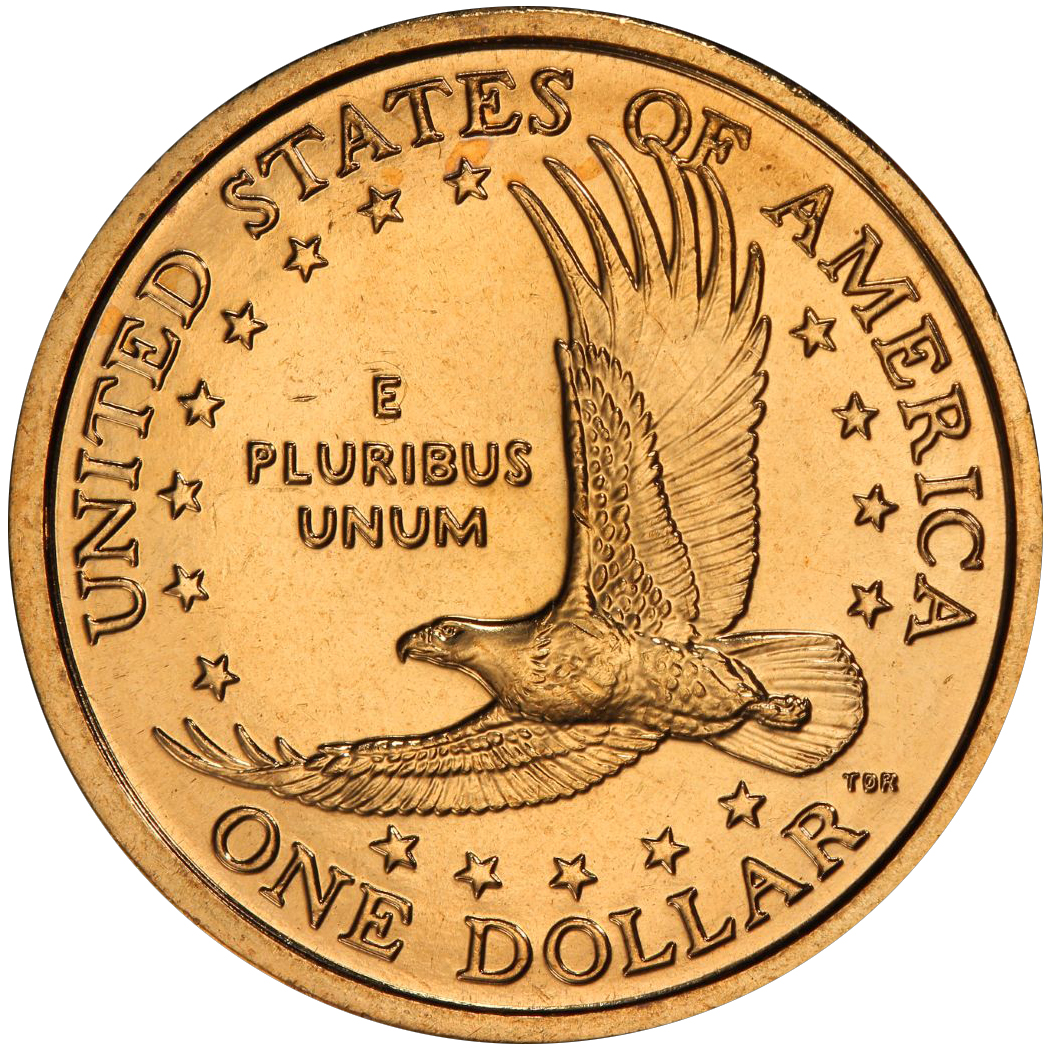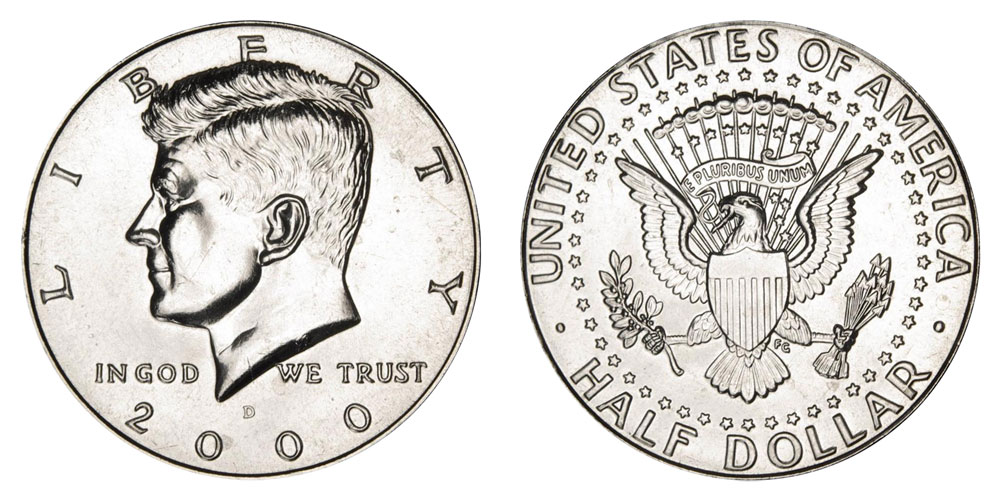2000 Dollar Coin
- 2000 Dollar Coin Shopping
- 2000 Dollar Coin Error
- 2000 Dollar Coin Wounded Eagle
- 2000 Dollar Coin Composition
The Sacagawea Dollar was introduced in 2000 as the new circulating dollar coin of the United States of America. During the first two years of issue, the coins were produced in large numbers amidst optimistic expectations for widespread circulation. When the public failed to embrace the coins, they were only struck in limited numbers for numismatic purposes. Starting in 2009, an annually rotating reverse design was adopted to accompany the familiar obverse design.
The series was originally authorized under the “United States Dollar Coin Act of 1997” signed into law by President Clinton in December 1997. The visual appearance of the coins included within the legislation was the following: “The dollar coin shall be golden in color, have a distinctive edge, have tactile and visual features that make the denomination of the coin readily discernible…”
These stipulations seemed aimed at correcting the perceived shortcomings of the previous dollar coin series, which had been easily confused with other denominations. The golden color was achieved by using an alloy of managanese brass for the outer layer of the coin. The edge was plain, as opposed to reeded, and the coins had a wide rim around the circumference.
2000 Dollar Coin Shopping
Glenna Goodacre created the obverse design for the Sacagawea Dollar. It features a portrait of Sacagawea, the Shoshone woman who accompanied Lewis and Clark on their expedition from 1804 to 1806. She carries her newborn son, Jean Baptiste Charbonneau, on her back. Since no contemporary image of Sacagawea exists, Goodacre used a 22 year old Shoshone woman named Randy’L He-Dow Teton as a model for the coin. To complete the obverse, the inscription LIBERTY appears above, with IN GOD WE TRUST in the left field, and the date and mint mark in the right field.
The original reverse of the coin portrays an eagle in flight designed by Thomas D. Rogers Sr. There are 17 stars around the eagle, representing each state in the Union at the time of the Lewis and Clark expedition. Above the eagle’s head is the motto IN GOD WE TRUST, with UNITED STATES OF AMERICA above, and ONE DOLLAR below.
From 2009 onwards, the obverse design of the coin was slightly altered by moving the date and mint mark to the edge of the coin, along with the motto E PLURIBUS UNUM. The reverse of the coin began to carry annually rotating designs celebrating the contributions and accomplishments of Native Americans. For this second stage of the series, mintages were initially higher due to production requirements within the authorizing legislation, however from 2012 onwards the coins have only been produced for distribution to collectors.
The history & value of the Sacagawea golden dollar minted in the year 2000. Between 1804 and 1806, Sacagawea traveled thousands of miles from North Dakota to the Pacific Ocean.
Sacagawea gold dollar coins were minted first from 2000 until 2008 and again with different reverse designs starting in 2009. These are popular coins but well over a billion have been minted since 2000. There are a couple of special varieties that are collectible like the 2000-P Cheerios coin. Get the best deals on 2000 One Dollar Coin when you shop the largest online selection at eBay.com. Free shipping on many items Browse your favorite brands affordable prices. The 2000-P 'Wounded Eagle' Sacagawea Dollar is so-named because of a raised die flaw that cuts across the eagle's belly (see the attribution image above). PCGS is not responsible for the accuracy or authenticity of Ebay listings. 2000 D Sacagawea Golden Dollar Coin The history & value of the Sacagawea golden dollar minted in the year 2000. Between 1804 and 1806, Sacagawea traveled thousands of miles from North Dakota to the Pacific Ocean. The 2000 American silver eagle bears an obverse image of Liberty walking toward the sunrise while holding an olive branch in her hands. This design actually debuted in 1916 on the half dollar and remained on that coin until 1947.
Sacagawea or Sacajawea was the Shoshone Indian woman who guided and helped Lewis and Clark in their exploration to the Western United States.
The following are the suggested spellings of Sacagawea:

Meriwether Lewis spelled it as Sahkahgarwea, Sahcahgagwea, Sarcargahwea and Sahcahgahweah; while Clark spelled it as Sahcahgahwea, Sahcahgarweah, Sahcargarweah, and Sahcahgar Wea.
The existence of the Sacajawea coin
The Sacagawea dollar was conceived to replace the unpopular and ill-fated Susan B. Anthony coin which was confused with the quarters because of their similarity in size, reeded edge, and indistinguishable color.
As a result, the Anthony dollar production was suspended and a new coin was produced that has different edge and a new metallic composition. However, it has the same size, weight, and diameter as with the previous mini-dollar coin.
Physical composition of Sacagawea coin
The Sacagawea dollar coin features distinctive qualities including: a golden color, extra-wide border, smooth edge like the nickels. It weighs 8.1 grams. Has a thickness of 2 mm, and has a diameter of 26.5 mm. The Sacagawea coin is a three-layer clad metal composed of pure copper core and two outer layers of 77 percent copper, 12 percent zinc, 7 percent manganese, and 4 percent nickel.
How a Sacagawea golden dollar looks like
The golden dollar’s obverse or heads featured the portrait of Sacagawea, the Shoshone Native American woman. The coin showed Sacagawea carrying her infant son, Jean Baptiste on her back.
Glenna Goodacre designed the obverse of the coin. She depicted Sacagawea with large, dark eyes as the Shoshone legends described her. Goodacre’s principal model for the coin was a college female student, Randy’L He-dow Teton.
The reverse of the coin featured a soaring eagle encircled by 17 stars and was designed by Thomas D. Rogers Sr. The eagle represented peace and freedom.
The seventeen stars appearing around the eagle embodied each State at the time of the Lewis and Clark expedition.
Numismatists dubbed the Sacagawea coin as the “golden dollar” because of its unique golden color. It has a smooth edge unlike the grooved Susan B. Anthony dollar. It also has a wider border than any other U.S. circulating coins.
The use of golden color was to ensure that the Sacajawea coin can easily be distinguished from other American coins.
Sacagawea dollar mintmarks
Sacagawea coins were the first Indian American dollar coin of the new millennium. The two branches of the U.S. Mint, the Philadelphia (P mintmark) and Denver (D mintmark) produced the Sacajawea coins. On the other hand, the proof Sacajawea coins with “S” mintmarks were made at the San Francisco mint.
Sacagawea proof sets
Proof sets of Sacagawea golden dollars were sold at a premium by the U. S. Mint.
The Sacagawea error coins
Like the Statehood quarters, Sacagawea dollars have started turning up with major minting mistakes.
The following are the Sacagawea error coin values:
2000 Dollar Coin Error
A 2000-P Sacagawea dollar or Type l (no rim) planchet which is literally blank is worth $500.

Another 2000-P Sacagawea dollar struck with 30 percent off center usually costs $3,500.

A 2000-P dollar struck 25 percent off center on a 30 percent straight off clip is worth $1,750.
A 30 percent clipped planchet of a 2000-P Sacagawea dollar costs $300.
2000 Dollar Coin Wounded Eagle
2000-P Sacagawea dollar struck on an aluminum is worth $9000 or more.
2000 Dollar Coin Composition
Lastly, the Sacagawea dollar “mule” double denomination error costs $75,000. The first double denomination mule error of U.S. Mint was a Washington quarter on the obverse and a Sacagawea dollar on the reverse.